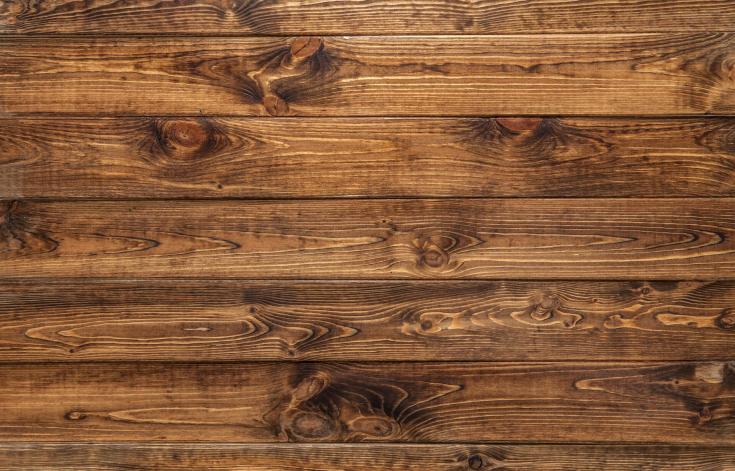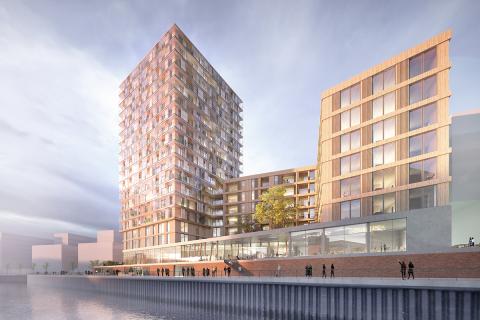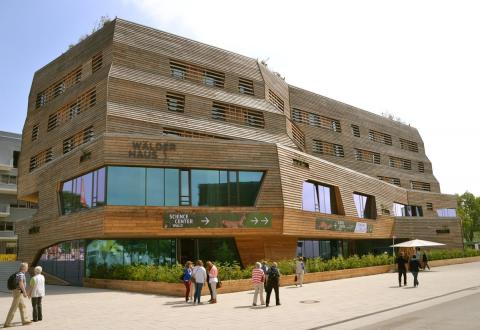Wood as a sustainable construction material

Life-cycle thinking and circularity are among the key principles for building renovation towards 2030 and 2050. As such, they have been enshrined in the Renovation Wave for Europe Strategy, adopted by the European Commission in October 2020 in the framework of the European Green Deal (EGD). According to the EU executive, to achieve a climate-neutral building stock in the long-term it is essential to invest in resource efficiency and circularity and to start seeing buildings as ‘carbon sinks’. This can be done by recurring to low-impact and bio-based construction materials, such as sustainably sourced wood, which store CO2 and avoid emissions associated with the production of conventional construction materials.
The New European Bauhaus initiative launched in January 2021 also points to the substantial role that wood as a building material can play in the design of 'beautiful, sustainable and inclusive forms of living together', thus contributing to turn the EGD into a tangible and aesthetically pleasant experience for all Europeans. Interreg Europe projects like REPLACE and CircPro are beginning to signal a growing reliance on wood as a sustainable construction material.
Supporting wood construction: a climate mitigation measure
In the context of REPLACE, the Hamburg Institute of International Economics (HWWI) conducted a thorough analysis of local circular economy practices which revealed that wood is increasingly being used in constructions thanks to the very favorable policy landscape created by the local government. The Free and Hanseatic City of Hamburg has started to support the use of wood as a construction material in 2017, driven by the need of reducing CO2 emissions from the building sector, which account for around 40% of local greenhouse gas emissions. Nowadays, besides cutting emissions, the use of wood for the production of lightweight and versatile construction modules which can be used for adding floors on top of existing buildings, is also proving to be instrumental in addressing another major environmental issue in Hamburg, namely the consumption of healthy soil, which is detrimental to biodiversity and also constitutes a driver of climate change.
Local financial schemes for wood as a construction material
As a public bank, the Investment and Support Bank of Hamburg (IFBHH) is sponsoring the use of wood for both non-residential and residential buildings through its ‘Holzbauförderung’ scheme. For non-residential buildings, the banking institute finances the construction of new buildings or the expansion of existing ones with wooden modules by giving 80 cents EUR per kg of wood, up to a maximum of 10,000 EUR. For residential buildings, the financial support amounts to 30 cent EUR per kg of wood, which generally equals a total of 5,000-6000 EUR for a 140m2 apartment. The fact that these figures can grow significantly in case of multi-floor houses with massive wooden parts represents a strong incentive for builders to replace conventional construction materials with wood.
Several projects using wood were authorised in Hamburg in the last few years, including a 65m high tower currently under realization in the Hafen City district, a student housing project with 371 apartments in the Wilhelmsburg area and 10 residential housing projects with over 180 private apartments. All of this makes Hamburg a 'wood construction pioneer' in Northern Germany, where the use of bio-based materials in buildings is still rather limited. Mirko Kruse, Researcher at the Hamburg Institute of International Economics declared: “The City of Hamburg is highly ambitious when it comes to the implementation of a circular economy. Using recycled or renewable materials in the construction sector is a great approach not only for sustainability but also for the visibility of new, circular solutions in everyday life”.

Image credit: störmer-partner.de
The Hamburg Strategy for sustainable wood constructions
The latest update (February 2020) of the Hamburg Climate Plan, which aims at a 55% CO2 emissions reduction by 2030 and at climate neutrality by 2050, identifies the use of sustainably sourced wood in constructions amongst the measures to achieve its targets. In addition, the Hamburg Parliament has decided to work on a ‘Wood Construction Strategy’, which is expected to see the light in 2022. The purpose of the Strategy would be to streamline all issues related to wood as a sustainable construction material, like funding, planning, economics and knowledge.
Local policymakers seem particularly determined to look at ways to measure and assess emission reductions enabled by wood in the building sector, design a well-functioning certification scheme, ensure that sustainably sourced wood is valued in public procurement decisions and that such a material becomes a fixture in all new public real estate projects. Asked about this Strategy, Mirko Kruse from the Hamburg Institute of International Economics commented: “It becomes clear how important political commitment is for a sustainable transformation. Changing the legislation and developing funding mechanisms has created a beneficial environment for sustainable constructions in Hamburg”.

Image credit: Wälderhaus from Wiki Commons
Rediscovering wood for construction: the case of Elverum
Just like Hamburg, the Norwegian Municipality of Elverum (Innlandet county) is also taking steps to create a policy environment that is more supportive of wood as a construction material. As a partner in the CircPro Interreg Europe project on ‘Smart and circular procurement’, Elverum is in fact reporting on its intention to adopt a strategy and a revised handbook on sustainable construction, with wood at their core. The strategy, to be endorsed at political level, will guide the planning/purchasing decisions of the administration with regard to public real estate projects. The revised handbook, on its part, will update a series of recommendations and guidelines on wood construction, which will be made available to all citizens and building companies. The goal being pursued in Elverum is to help reduce the high carbon footprint of the construction sector, primarily due to energy- and resource-intensive production processes linked to conventional materials such as steel and concrete. How to achieve this goal? By relying more on a sustainable and locally abundant product with an important carbon storage capacity: wood!
The New EU Forest Strategy: promoting long-lived wood products
Published by the Commission on 16 July 2021 under the ‘Fitfor55’ package, the new EU Forest Strategy for 2030 is set to enhance the multifunctional role of forests in achieving climate neutrality, putting biodiversity on the path to recovery and supporting a circular bioeconomy. To achieve these goals, the new Strategy calls the forest-based sector to optimise the use of wood in accordance with the cascading principle, which also entails prioritising the resource-efficient production of long-lived building materials to replace carbon-intensive and fossil-based ones.To help turning the construction sector ‘from a source of greenhouse gas emissions into a carbon sink’, the Strategy set forth the intention of the EC to develop a 2050 roadmap for reducing whole life-cycle carbon emissions in buildings and to define a methodology to quantify the climate benefits of wood construction products in the next revision of the Construction Product Regulation.
Moreover, the Strategy specifies that innovative wood construction projects will be eligible for support under the Innovation Fund, which gathers revenues of the EU Emission Trading System (EUETS) and ensures they are reinvested in the transition to climate neutrality. All of this is expected to trigger a wider reliance on wood construction materials within the boundaries of the availability and supply of wood as a raw material in all EU regions, which can already be inspired by virtuous frontrunners like Hamburg and Elverum.
More inspiration and information
- Good practice: Passive Wooden Kindergarten Storžek (BUILD2LC project)
- Good practice: Galaxen förskola "Low energy building Preschool" (EMPOWER project)
- Good practice: InnoRenew (RETRACE project)
- Article on Wood tested as viable substitute for multi-story buildings in Italy and Austria
- Bigwood project, Interreg Italy-Austria
- Formawood project, Interreg France-Wallonie-Vlaanderen
- IMIP project, Interreg Sudoe
- Wood4bauhaus (the Wood Sector Alliance for the New European Bauhaus)
